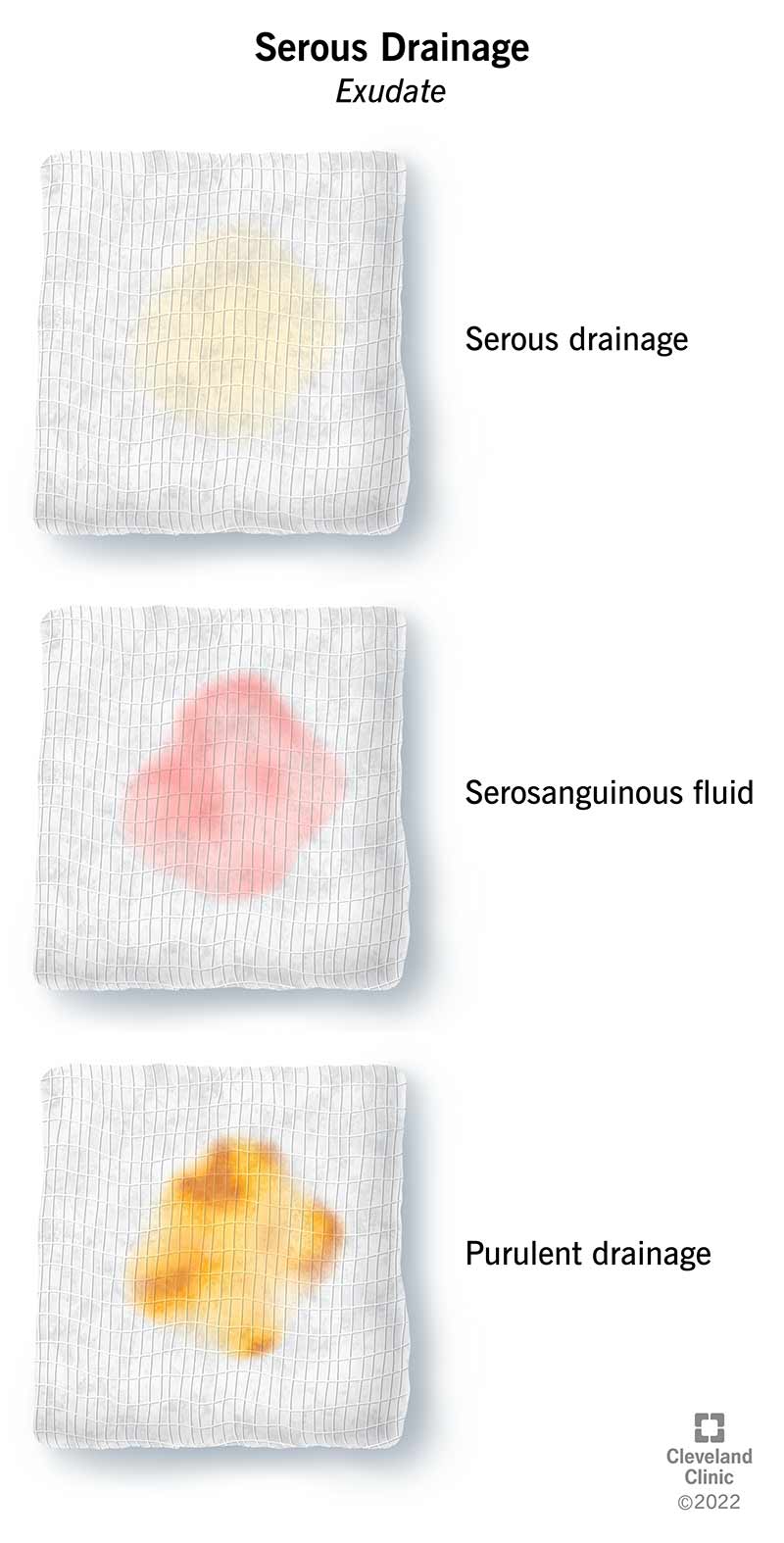Serous drainage is a clear to yellow fluid that leaks out of a wound. It’s slightly thicker than water. It’s the fluid that makes your bandage look and feel wet. This type of wound drainage is a normal part of your body’s healing process. Too much serous fluid is a sign of an infection.
Advertisement
Cleveland Clinic is a non-profit academic medical center. Advertising on our site helps support our mission. We do not endorse non-Cleveland Clinic products or services. Policy

Serous drainage, or blood serum, is a type of fluid that comes out of a wound with tissue damage. It’s normal for your wound to leak small amounts of this clear fluid. However, if you notice your wound drains a lot of fluid, or if the fluid draining is thick like pus, contact a healthcare provider. A lot of serous fluid or pus leaking from the wound can indicate the presence of a bacterial infection.
Advertisement
Cleveland Clinic is a non-profit academic medical center. Advertising on our site helps support our mission. We do not endorse non-Cleveland Clinic products or services. Policy
Serous drainage is a clear to yellow fluid. The texture of serous drainage is slightly thicker than water. When you remove the bandage that covers your wound, you may see a wet outline in the gauze of your bandage.
Serous drainage is plasma without proteins. Plasma is the liquid base of blood. Plasma is over 90% water and less than 10% solids. The solids include proteins like fibrinogen, which is a protein that your liver makes to help with blood clotting.
When you get a wound and start to bleed, blood proteins stop below the surface of your skin at the wound to limit bleeding by coagulating. During coagulation, your proteins change your liquid blood into a semisolid state. This process prevents you from losing too much blood. As a result, liquid plasma (without proteins) moves to the surface of the wound while the proteins stay behind.
Serous drainage is a sign that your immune system is working correctly to heal a wound. Serous drainage is normal in small amounts. Large amounts of serous drainage can be a sign of an infection, so reach out to a healthcare provider if you have a lot of wound drainage.
There are three different types of fluid in addition to blood that come from a wound, including:
Advertisement
Serous drainage occurs when your body heals a wound. It’s important for your body to direct blood and other body fluids to the site of a wound to start the healing process. Your immune system starts the process of inflammation, which sends components of your immune system to the wound to destroy invaders like bacteria that can make you sick. The process of bringing fluids to the site of a wound causes it to have serous drainage. You may also have serous drainage if you have a significant amount of swelling beneath your skin.
There are three types of wounds that can cause serous drainage, including:
You may also have serous drainage after surgery.
Serous drainage will stop on its own as your wound heals. Treating your wound helps serous drainage go away and can help prevent infection. To take care of your wound, you should:
Follow a healthcare provider’s instructions if they mention a specific way that you need to take care of your wound.
In most cases, repeated use of alcohol or hydrogen peroxide can lengthen your healing process or prevent a wound from healing properly. Ask your healthcare provider what you should apply to your wound.
Advertisement
No. Serous drainage isn’t dangerous when it occurs in small amounts in your bandage. This is a normal process of how your body heals. Contact a healthcare provider if you notice your wound leaks a large amount of fluid or if your bandages seem to be soaked with fluid when you change them.
Visit a healthcare provider if:
You don’t need to worry about serous fluid since it’s a normal part of how your body heals itself. When you have a small wound, you can take care of it at home by cleaning your wound and applying a new bandage at least once per day. If you experience soggy bandages that need changing frequently or you have severe pain or swelling at the site of your wound, visit a healthcare provider.
Advertisement
Need care fast? Cleveland Clinic’s Express Care and Urgent Care locations treat everything from sprains to sinus infections — no appointment needed.

Last reviewed on 05/30/2023.
Learn more about the Health Library and our editorial process.